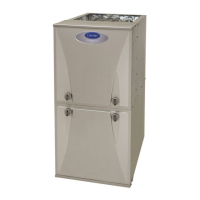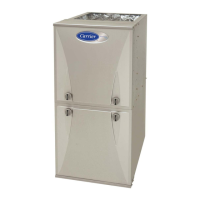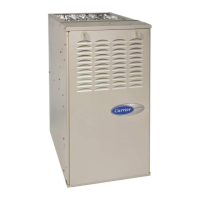PG92MSA: Installation, Start-up, Operating and Service and Maintenance Instructions
Manufacturer reserves the right to change, at any time, specifications and designs without notice and without obligations.
36
Locating the Vent Termination
General
NOTE: Termination Requirements for the Provinces of Alberta and
Saskatchewan are located at the end of this section.
Combustion-air inlet pipe (direct vent/2-pipe system only) and vent pipe
must terminate outside structure, either through sidewall or roof.
Special termination requirements may be required in other Canadian
provinces. Refer to the authority having jurisdiction for clarification
and/or additional clearance requirements.
For vent termination clearance, references to National codes are shown
in Fig. 43 for Direct Vent/2-Pipe system and Fig. 44 for Ventilated
Combustion Air/Non-direct Vent/1-Pipe system. For exterior
termination arrangements, refer to Fig. 40 for Direct Vent/2-Pipe system
and Fig. 41 for Ventilated Combustion Air/Non-Direct/1-Pipe system.
Contact Local code authorities for other requirements to and/or
exemptions from the National codes shown in the figures.
Roof termination is the recommended termination location. Roof
terminations provide better performance against sustained prevailing
winds. The roof location is preferred since the vent and combustion air
system is less susceptible to damage or contamination. The termination
is usually located away from adjacent structures or other obstacles such
as inside corners, windows, doors or other appliances. It is less prone to
icing conditions, and it often has less visible vent vapors.
Sidewall terminations may require sealing or shielding of building
surfaces with a corrosive resistance material due to the corrosive
properties of combustion products from the vent system, as well as
protection of adjacent structures.
When determining appropriate location for termination, consider the
following guidelines:
1. Comply with all clearance requirements stated in Fig. 43 or Fig. 44
per application.
2. The vent termination must be located at least 3 feet from an inside
corner and follow the clearance distances in the Inside Corner
Termination drawing. See Fig. 42.
3. Termination or termination kit should be positioned where vent
vapors will not damage plants/shrubs, air conditioning equipment
or utility meters.
4. Do not locate termination directly into prevailing winds.
Termination should be positioned so that it will not be affected by
sustained prevailing winds over 30 mph, wind eddy, such as inside
building corners, or by recirculation of flue gases, airborne leaves,
or light snow.
5. Termination or termination kit should be positioned where it will
not be damaged by or subjected to foreign objects such as stones,
balls, etc.
6. Termination or termination kit should be positioned where vent
vapors are not objectionable.
Direct Vent / 2-Pipe System
Direct vent (2-pipe) vent and combustion air pipes must terminate
outside the structure. See Fig. 43 For references to vent clearances
required by National code authorities. Allowable vent and combustion
air terminations are shown in Fig. 40.
A12220
Fig. 45 – Sample Inlet Air Pipe Connection for Polypropylene
Venting Systems
A96128
Fig. 46 – Pipe Vent and Combustion
Ventilated Combustion Air
The vent pipe for a Ventilated Combustion Air System must terminate
outdoors. See Fig. 44 for references to vent clearances required by
National code authorities. Allowable vent terminations are shown in
Fig. 41. The combustion air pipe terminates in a well-ventilated attic or
crawl space. Follow the clearances as shown in Fig. 48.
The combustion air pipe cannot terminate in attics or crawl spaces that
use ventilation fans designed to operate in the heating season. If
ventilation fans are present in these areas, the combustion air pipe must
terminate outdoors as a Direct Vent System.
WARNING
!
CARBON MONOXIDE POISONING HAZARD
Failure to follow the instructions outlined below for each appliance
being placed into operation could result in carbon monoxide poisoning
or death.
The instructions included with this furnace DO NOT APPLY to vent
systems that are located below the furnace. CAREFULLY FOLLOW
THE INSTRUCTIONS PROVIDED WITH THE EXTERNAL
VENT TRAP KIT FOR LAYING OUT THE VENTING SYSTEM
AND THE DRAIN SYSTEM when all or part of the venting system is
placed below the furnace.
Proper configuration of the venting and drain system is critical when
placing all or part of the venting system below the level of the furnace.
VENT GASSES COULD BE RELEASED FROM THE
DRAINAGE SYSTEM if the instructions provided with the External
Vent Trap Kit are not followed.
NOTICE
!
RECOMMENDED SUPPORT FOR VENT
TERMINATIONS
It is recommended that sidewall vent terminations in excess of 24
inches (0.6 M) or rooftop terminations in excess of 36 inches (1 M) in
vertical length be supported by EITHER the Direct Vent Termination
Kit shown in Table 12 or by field-supplied brackets or supports
fastened to the structure.

